
The Agaricales are an order of fungi in the division Basidiomycota. As originally conceived, the order contained all the agarics, but subsequent research has shown that not all agarics are closely related and some belong in other orders, such as the Russulales and Boletales. Conversely, DNA research has also shown that many non-agarics, including some of the clavarioid fungi and gasteroid fungi belong within the Agaricales. The order has 46 extant families, more than 400 genera, and over 25,000 described species, along with six extinct genera known only from the fossil record. Species in the Agaricales range from the familiar Agaricus bisporus and the deadly Amanita virosa to the coral-like Clavaria zollingeri and bracket-like Fistulina hepatica.

The Hymenochaetales are an order of fungi in the class Agaricomycetes. The order in its current sense is based on molecular research and not on any unifying morphological characteristics. According to one 2008 estimate, the Hymenochaetales contain around 600 species worldwide, mostly corticioid fungi and poroid fungi, but also including several clavarioid fungi and agarics. Species of economic importance include wood decay fungi in the genera Phellinus and Inonotus sensu lato, some of which may cause losses in forestry. Therapeutic properties are claimed for Inonotus obliquus ("chaga") and Phellinus linteus, both of which are now commercially marketed.

The Hygrophoraceae are a family of fungi in the order Agaricales. Originally conceived as containing white-spored, thick-gilled agarics, including Hygrophorus and Hygrocybe species, DNA evidence has extended the limits of the family, so it now contains not only agarics, but also basidiolichens and corticioid fungi. Species are thus diverse and are variously ectomycorrhizal, lichenized, associated with mosses, or saprotrophic. The family contains 34 genera and over 1000 species. None is of any great economic importance, though fruit bodies of some Hygrocybe and Hygrophorus species are considered edible and may be collected for sale in local markets.
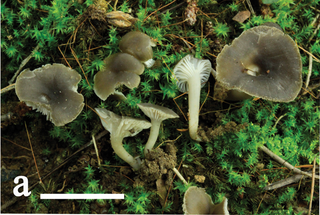
Camarophyllopsis is a genus of agarics in the family Clavariaceae. Basidiocarps are dull-coloured and have dry caps, rather distant, decurrent lamellae, white spores, and smooth, ringless stems. In Europe species are characteristic of old, unimproved grasslands which are a declining habitat, making them of conservation concern.
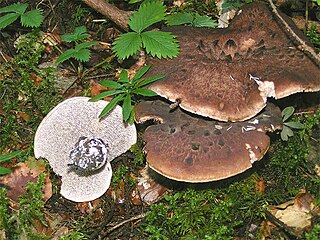
The Thelephorales are an order of fungi in the class Agaricomycetes. The order includes corticioid and hydnoid fungi, together with a few polypores and clavarioid species. Most fungi within the Thelephorales are ectomycorrhizal. None is of any great economic importance, though Sarcodon imbricatus is edible and commercially marketed, whilst several species have been used for craft dyeing.

The Tricholomataceae are a large family of fungi within the order Agaricales. Originally a classic "wastebasket taxon", the family included any white-, yellow-, or pink-spored genera in the Agaricales not already classified as belonging to e.g. the Amanitaceae, Lepiotaceae, Hygrophoraceae, Pluteaceae, or Entolomataceae.
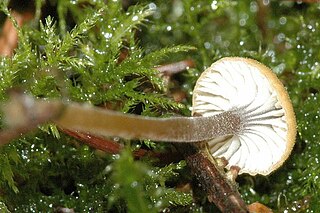
Rickenella is a genus of brightly colored bryophilous agarics in the Hymenochaetales that have an omphalinoid morphology. They inhabit mosses on mossy soils, peats, tree trunks and logs in temperate regions of both the Northern and Southern Hemispheres. Phylogenetically related agarics are in the genera Contumyces, Gyroflexus, Loreleia, Cantharellopsis and Blasiphalia, as well as the stipitate-stereoid genera Muscinupta and Cotylidia. and the clavarioid genus, Alloclavaria.

Alloclavaria is a clavarioid genus in the Hymenochaetales recently segregated from Clavaria by molecular analysis. Phylogenetically related fungi are in the agaricoid genera Rickenella, Contumyces, Gyroflexus, Loreleia, Cantharellopsis and Blasiphalia, as well as the stipitate stereoid genera Cotylidia and Muscinupta. The only species as yet placed in Alloclavaria is the type, formerly known as Clavaria purpurea under which name it is often cited or illustrated.. It is suspected, via circumstantial evidence, i.e. habitat, but not proven, that Alloclavaria is mycorrhizal.

The Physalacriaceae are a family of fungi in the order Agaricales. Species in the family have a widespread distribution, ranging from the Arctic, (Rhizomarasmius), to the tropics, e.g. Gloiocephala, and from marine sites (Mycaureola) and fresh waters (Gloiocephala) to semiarid forests (Xerula).

Ramariopsis kunzei is an edible species of coral fungi in the family Clavariaceae, and the type species of the genus Ramariopsis. It is commonly known as white coral because of the branched structure of the fruit bodies that resemble marine coral. The fruit bodies are up to 5 cm (2.0 in) tall by 4 cm (1.6 in) wide, with numerous branches originating from a short rudimentary stem. The branches are one to two millimeters thick, smooth, and white, sometimes with yellowish tips in age. Ramariopsis kunzei has a widespread distribution, and is found in North America, Europe, Asia, and Australia.

Infundibulicybe is a genus of fungi that is robustly placed incertae sedis as sister group to the Tricholomatoid clade. It has previously been part of the family of Tricholomataceae, but recent molecular phylogeny has shown it to take an isolated position within the Agaricales.
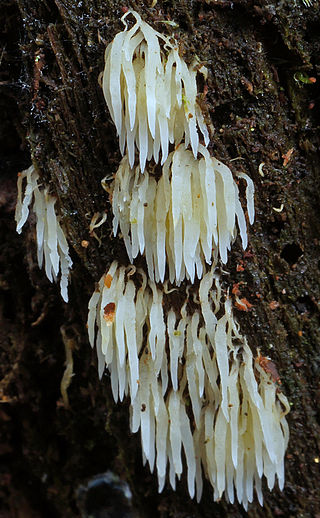
Mucronella is a genus of fungi in the family Clavariaceae. Species in the genus resemble awl-shaped teeth that grow in groups without a common subiculum.

The clavarioid fungi are a group of fungi in the Basidiomycota typically having erect, simple or branched basidiocarps that are formed on the ground, on decaying vegetation, or on dead wood. They are colloquially called club fungi and coral fungi.

Trechispora is a genus of fungi in the family Hydnodontaceae. Basidiocarps are variously corticioid or clavarioid with spore-bearing surfaces that are variously smooth to hydnoid or poroid. The genus occurs worldwide, though individual species may be localized. Around 50 species have been described to date.
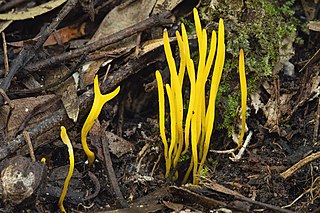
Clavulinopsis amoena is a clavarioid fungus in the family Clavariaceae. It forms slender, cylindrical, golden-yellow fruiting bodies that grow on the ground among plant litter. It was originally described from Indonesia and appears to be distributed in temperate areas of the southern hemisphere.

Clavulinopsis helvola is a clavarioid fungus in the family Clavariaceae. In the UK, it has the recommended English name of yellow club. It forms slender, cylindrical, yellow fruiting bodies that grow on the ground in agriculturally unimproved grassland or in woodland litter. It was originally described from Europe.

Clavulinopsis laeticolor is a clavarioid fungus in the family Clavariaceae. In the UK, it has the recommended English name of handsome club. It forms slender, cylindrical, yellow fruit bodies that grow on the ground in woodland litter or in agriculturally unimproved grassland. It was originally described from Cuba and is part of a species complex as yet unresolved.
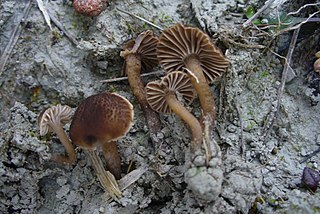
Hodophilus is a genus of agarics in the family Clavariaceae. Basidiocarps are dull-coloured and have dry caps, rather distant, decurrent lamellae, white spores, and smooth, ringless stems. In Europe species are characteristic of old, unimproved grasslands which are a declining habitat, making them of conservation concern. Several species have a distinct odour of napthalene.

Clavulinopsis corniculata is a clavarioid fungus in the family Clavariaceae. In the UK, it has the recommended English name of meadow coral. It forms branched, cylindrical, ochre fruit bodies that grow on the ground in agriculturally unimproved grassland or in woodland litter. It was originally described from Germany and is part of a species complex as yet unresolved.
























